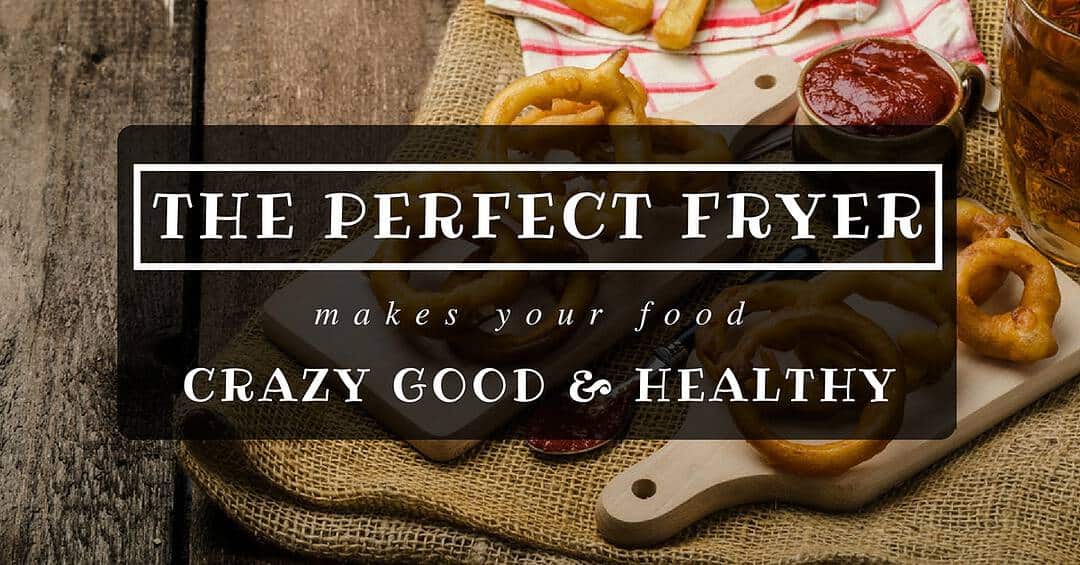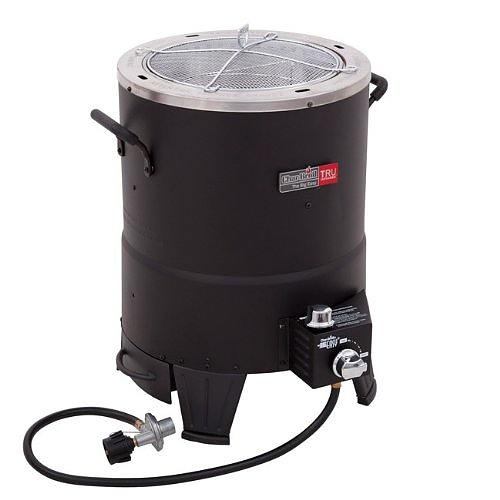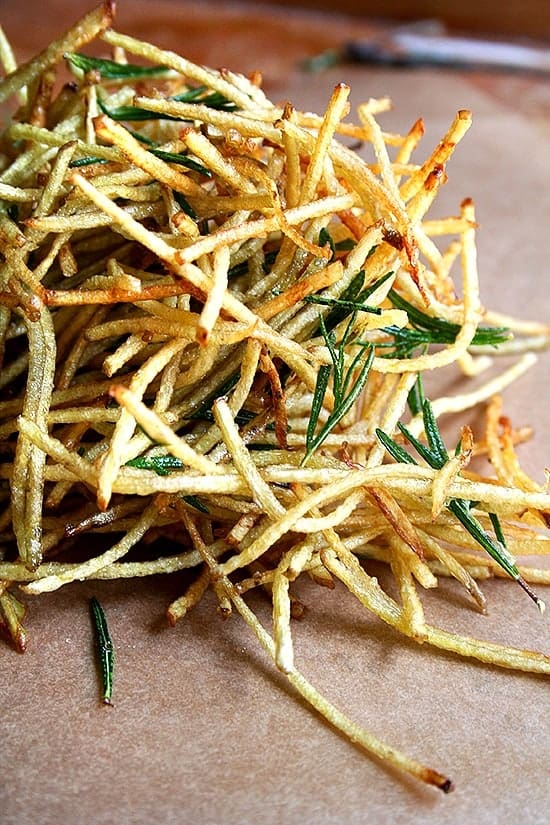Fried food is the epitome of deliciousness. Creating a crispy coating that gives way to juicy meat as you bite down is one of the fastest ways to declare your mastery of the culinary arts.
It's also great to be able to serve crunchy chips and perfect french fries. Unfortunately, fried food can also be a quick path to clogged arteries. What's a foodie to do? Find the best oil-less fryer around.
More...
Rank | Image | Product Name | Score | |
|---|---|---|---|---|
1
|
96
/100
| |||
2
|
93
/100
| |||
3
|
87
/100
| |||
4
|
85
/100
| |||
5
|
81
/100
|
Oil-Free Options
In order to cook food using no oil or less oil, a fryer has to have a way to both generate heat, and direct it toward the food that is being cooked. Most modern oil-free systems use the shape of the cooking vessel to direct heat toward the food.
They also utilize either an electric heat source that employs a metal heating element to produce heat like a toaster does, or a radiant element to generate infrared heat.
Fryers used to often include fans that circulated the heat, but improvements in materials and manufacturing have largely eliminated this method.
Almost all modern systems now employ some manner of indirect and infrared heating within a slightly rounded pot.
As strange as it might sound, not all oil-less fryers are entirely oil free. When you're searching for a model, you should scan all the marketing materials for key phrases.
For example, many models that still use oil will tout that they use "80 percent less oil." These fryers typically use oil to add a bit of taste, and the oil can also act as an indirect heat source.
While all models sold as oil-less fryers do not require you to dunk your food in oil, some do still need oil to produce heat. A little bit of reading can be beneficial if you're dedicated to going fully oil free.
Health Benefits
Most cooks who choose an oil-less fryer do so because they're looking to improve the healthiness of their foods without sacrificing taste or texture.
Cooking oils are notoriously unhealthy, especially those that are sold for deep frying purposes.
They're often hydrogenated, using a process that can actually make negative health effects worse.
Oil producers use this method to ensure the shelf life and stability of their products, but that's for their benefit, not yours.
Oil-free frying methods tend to yield meals that are lower in fat. Fats released by cooked foods are drained away from the cooking center in most fryers.
This also comes with the added benefit of producing a crispier food surface.
Allergies
Modern cooks are pressured more than ever before to accommodate the needs of those with allergy issues.
Producers of cooking oils often don't sell an entirely pure product, which can make it difficult to guarantee that your foods won't trigger allergic reactions.
It can be a pain to find an appropriate oil for a particular diner's needs, not to mention that the right oil may be very costly.
Efficiency
Bringing an entire pot of oil up to full cooking temperature takes a surprisingly large amount of energy.
The majority of air fryers are actually more energy-efficient than their oil-based deep fryer counterparts.
It may not seem like a big deal to count the electricity that goes into making a french fry, but those costs can quickly add up over a few years.
If you use your oil-less fryer long enough, it has the potential to pay for itself in reduced electric bills.
Taste and Texture
Anything deep fried in oil has a tendency to end up tasting like whatever oil was used. That's fine for many recipes.
If a dish typically calls for a peanut oil, there's a good chance that the hint of peanut oil taste is desirable.
However, that's not always the case for many fried foods. If you're making a jalapeno popper, for example, you'll want it to taste like a jalapeno.
Foods that have been deep fried also tend to retain a bit of the oil no matter how well you try to drain them afterwards.
It can save time by eliminating the need for further draining, and that can help you get meals from the kitchen to the table faster.
My Reviews
Rank | Image | Product Name | Score | |
|---|---|---|---|---|
1
|
96
/100
| |||
2
|
93
/100
| |||
3
|
87
/100
| |||
4
|
85
/100
| |||
5
|
81
/100
|
*Below, you'll find our more detailed reviews, but you can also click the links above to see current prices or read customer reviews on Amazon.
This model from VonShef is another one that allows you to decide whether you want to go entirely oil free or add a bit for flavor.
It does a very good job of producing crispy results, so it's a great option for anyone who's looking to make fries or potato chips at home.
It leaves almost no oil taste, which is either a pro or a con depending on what you're shooting for.
That does, however, make it a superb choice for anyone who wants to cook vegetables that taste fresh and crispy without any oil residue.
There's no denying that this model can be noisy when in operation. If you're looking for a fire-and-forget appliance, it's not the one for you.
It is also bigger than other models on this list, so it may not be the best choice for a small apartment kitchen.
Editor's Rating: 96/100
Pros
- Produces excellent crispness
- Oil-free taste even when cooking with oil
- Small basket given the device's size
- Great for chips, fries and veggies
- Cooks everything up to and including steak
- Somewhat lower price point than competitors
Cons
- This machine is very noisy when frying.
- It consumes more counter space than most models, especially with the pot handle.
Having options is always nice, and this model from Black+Decker allows you to use either the fully oil-free approach or a method that requires a little bit of oil.
Its relatively large capacity makes it ideal for all but the biggest meals. It also offers a 60-minute timer that allows you to fire up and forget.
One disappointment I have had with this model is that the cooking temperature is a little limited. Y
ou can cook food from 175 to 400 degrees Fahrenheit. I'm someone who likes food to be extra crispy, and this model working for 60 minutes at 400 degrees doesn't always produce the desired result.
It uses an air circulation method that is less than ideal, yielding somewhat dry food. I found that it took practice to get the cooking times right when I wanted fully cooked meats. It is, however, great at making veggies!
Editor's Rating: 93/100
Pros
- Excellent size for apartments or dorms
- Simple design and appealing look
- Easy to use
- Permits both oil-free and reduced-oil cooking options
Cons
- Timer doesn't provide sufficient cooking time for many meals.
- Cooking space is a bit small.
- Basket is less than convenient.
- Oil has a tendency to mist and stick to foods.
If you're looking for a guaranteed oil-free cooking experience, this appliance from Le Coucou may be the ticket. It's a 2-quart model, which is sufficient for most applications but not ideal for cooking larger meals.
The model, however, is sold as a space saver and an apartment-friendly appliance. Its longest dimension is merely 13 inches, so it really will fit nicely onto any counter area you might have available for it.
It produces a lot of heat and a lot of drying. Unfortunately, it seems to go a bit overboard. For example, I found that any breading I put on my food ended up a bit too dry and crunchy.
If you do have to bread a food item and cook it with this air fryer, you may want to apply the breading later in the process.
Editor's Rating: 87/100
Pros
- Takes up little space
- Has a very appealing design
- Is very simple to operate
- Provides an entirely oil-free cooking experience
- Great at cooking crispier vegetables
Cons
- Air circulation is a bit aggressive and dries some foods out.
- Instructions are a bit lacking.
- Packaging seems less than ideal.
- Cooking temperature only goes up to 390 degrees Fahrenheit.
If you're searching for a model that has more of an iPhone look than a kitchen appliance vibe, the Philips Digital AirFryer could make an interesting addition to your cooking arsenal.
It's a bit bigger than some of the other models on this list, but it's not large enough to make something like turkey. You could probably fit a smaller ham in there, however. The digital readout and simple keypad makes operating this model a breeze.
The Philips AirFryer also comes with fairly thorough instructions, which are always beneficial when you're getting to know an entirely new type of appliance. It may be a bit of a space hog, though, if you have a small kitchen.
I found this model to be the easiest one on my list to clean. It doesn't quite produce the perfect level of crispiness that I desire, but cooking times are very speedy.
Editor's Rating: 85/100
Pros
- Somewhat larger design
- Very easy to clean
- Simple operation
- Great for turning on and forgetting
- Produces great results for vegetables and potatoes
Cons
- Basket and handle can get very hot.
- This model uses less oil rather than being oil free
- Results are somewhat crunchy, but the fryer doesn't create a perfect crisp
- This fryer is rather expensive
Don't let the term "turkey fryer" throw you off. The only thing that makes a turkey fryer different from other available options is that it's large enough to fry a whole turkey, and I feel safe in saying that's a win in its own right.
This model is built in a stovepipe design that allows you to lower a multi-tier rack into it. That means you can cook a number of different items at the same time.
It also makes retrieving your food a bit more convenient.With a big model like this one, you'll likely want to use it outdoors.
Fortunately, it easily throws off enough heat to handle the colder temperatures in the winter months. It's also notable that this model requires the use of a small amount of oil.
Editor's Rating: 81/100
Pros
- Massive size with plenty of cooking space
- Ideal for outdoor use
- Great for use in cold weather
- Provides an entirely oil-free cooking experience
- Great at cooking crispier vegetables
Cons
- It's not entirely oil free.
- Build quality is a bit flimsy.
- It's too big for some indoor applications.
- Cooking times tend to be a bit longer than advertised.
- Fully cooked food often ends up a bit dry
- It lacks a good shape for fully directing heat towards the food.
- Char-Broil the Big Easy TRU-Infrared Oil-Less Turkey Fryer
My Conclusion
The VonShef Air Fryer is the clear winner to me. It allows me to cook in an entirely oil-free manner, and it produces the level of crispiness that I prefer.
Most air fryers have some problems; either by drying foods out too much or by not getting the exteriors perfectly crunchy.
This is the fryer that comes the closest to being just right, and the low price is nice, too.
Are you feeling inspired to try out the brave new world of oil-less cooking? Tell me your thoughts in the comments section. If you found the information in this article valuable, please take some time to share it on social media.










